Principles, sets and options
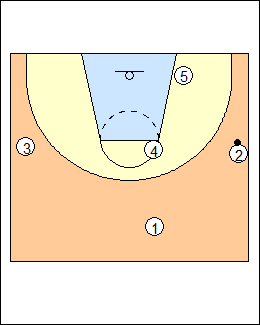 | 1 Zone offence progressions - basic sets, tilted sets, running the corners, and post x-cuts: 3) 2-3 (three deep) 4) 3-out 2-in, overload Principles of zone attack - fast break (beat the zone up the floor) - line up in the gaps - move the ball - shallow cut - drive a gap (draw two defenders), pass - freeze dribble (right at a defender), pass - make the extra pass (pass-pass) - quick, full ball reversal - skip pass - fake a pass to make a pass - flash middle from weakside - get the ball inside to score, or inside-out for 3s (collapse the zone) - use the high post (keep the defence in) - get behind the zone on the baseline (flatten the zone) - attack the short corner, heels to the baseline - run the baseline (a post or shooter) - overload the zone (side, top, bottom) - screen the zone - crash the boards. Bill Self - the ball moves the zone. Mike Dunlap - the zone hates full reversal to the corner. coachesclipboard.ca - getting the ball into the middle of the zone is a fundamental principle, this can be done by dribble penetration, flashing into the middle, or posting at the elbows. Flash from behind the zone with your back to a sideline, hands up, stop or pause in a gap between the top and bottom rows of the defence. Randy Sherman - flash middle from weakside, aim for the bottom of the "dots" (jump circle), can fan the ball opposite. Coach Daniel - drive the gaps or baseline behind the zone. Kirby Schepp - you want to change sides, get paint touches, and attack with the dribble then pass-pass. |
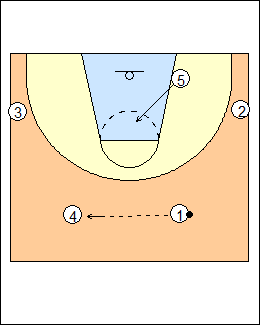 | 2 a) 4-out 1-in This typical man-to-man set can be used against any zone, but especially a 1-2-2 or 1-3-1. Jay Wright - try to run your man-to-man offence against zones. Ballscreens are highly effective, especially with shooters. Jeff Bauer - 5 begins behind the zone on the baseline. Randy Sherman - against a 1-2-2, filling the gaps means lifting 2 and 3 above the dead corners. See Zone offences - Duke, Villanova, USA, Bauer.  |
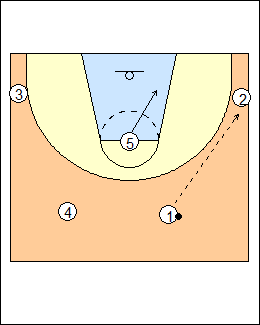 | 3 b) 2-1-2 5 has the high post when the ball is out top, dives on a pass to a corner. Use against a 1-3-1 (or 1-2-2) zone defence, or against any halfcourt trapping pressure. Against pressure defence, have weakside 4 or 3 flash to the high post on a pass to 2. Option - 5 can ballscreen out top, or screen the middle defender of a 1-3-1 zone. See 5star 2-1-2, Villanova, 2-1-2, Schepp vs 1-3-1, Offence - Wootten four to score, Ballscreens vs 1-3-1. Variation - 5 stays low for rebounding, see Pitt vs. 1-3-1.  |
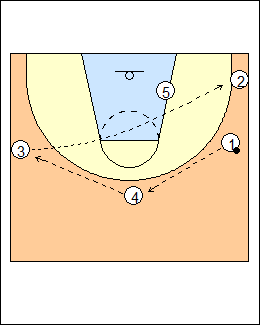 | 4 |
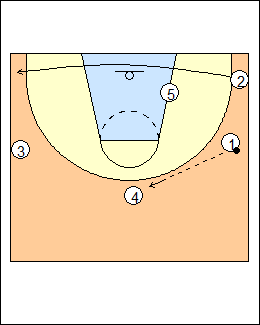 | 5 d) Duke runner The corner shooter runs the baseline. Can be used against most zones. Look to get full ball reversal (corner to corner). Start with an entry pass away from the shooter, bring the ball back. 1 has three short pass options (an overload). Optionally 1 basket cuts on a corner pass to 2, see Clock, 1-3-1 rotation, also 5star Iowa, Atkins Iowa. 3 can ballscreen for 4, see Larry Brown ballscreen. 4 can ballscreen to help reverse the ball, or 3 can flash to the high post from weakside, or 5 starts in the high post (and dives on a pass to 2). 5 can pin-screen and ballscreen from the high post or low post. |
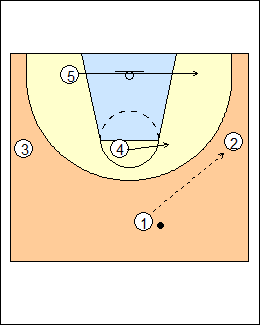 | 6 a) 1-3-1 5 goes short corner to short corner (but can first flash middle), 4 has the high post. Use against an even-front zone (or trapping odd-front zone). Tom Izzo, Jack Bennett - never have 1 and 4 in a tandem. Coach Daniel - 1-2-3 are free to move anywhere along the perimeter so long as they keep good spacing. Go inside to score, or inside-out to get good looks at 3s. Kermit Davis - use a 1-3-1 set against a trapping 1-3-1. Ken Atkins - use a 1-3-1 set if the defence is trapping a two-guard set. See 1-3-1 basics, Grinnell, also Kermit Davis vs (trapping) 1-3-1, Press breaks - Halfcourt Atkins.  |
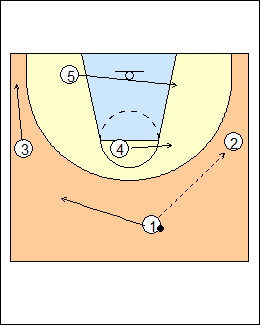 | 7 b) High-low From a 1-3-1 set, 1 passes to a wing and spaces away into a high-low, reverse the ball by skip pass or through 4. Can be used against most zones. See High-low basics, High-low, Geno Auriemma, Hubie Brown 1-4, also Offence - High-low.  |
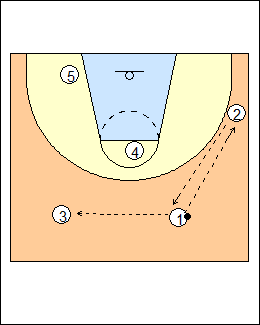 | 8 c) Offset 2-1-2 Two guards, high post, shooter on one side, low post opposite, use against a 1-2-2 or 1-3-1 zone. Look to get the ball to 4. Option - 4 can step out to reverse the ball. Tilted 1-3-1 - 5 comes ballside on the pass to 2, goes back on a return pass to 1. See Michigan State vs 1-3-1, Dave Odom vs 1-3-1, Schepp vs 1-3-1.  |
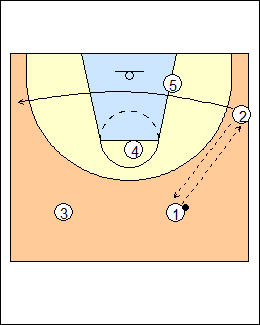 | 9 d) Two-guard runner Two guards, high post, ballside low post (on the baseline), a shooter is the runner. 4 can ballscreen, or step out top into Duke runner. Variation - 5 goes block-to-block, 2 runs the baseline below 5. See Overload, below (4 and 5 x-cut). |
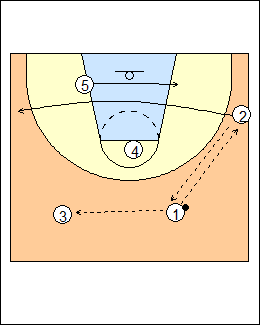 | 10 Other options, e.g. against a 1-3-1 zone - 5 starts weakside, comes ballside on a pass to 2, stays until 3 finishes a swing to 2 on the other side, see Dave Odom vs 1-3-1 (2 and 4 exchange on ball reversal) - 5 is always weakside when 1 or 3 has the ball, see Press breaks - halfcourt Atkins Wisconsin - 5 plays the short corners, see Defence - 1-3-1 Blackford (overload) - diagonal skip passes to 2, see X-gap vs 1-3-1 (5 screens) - double high posts, see X-gap vs 1-3-1, Elbows vs 1-3-1 - 4 steps out to the ballside wing to create an overload, see Defence - 1-3-1 DeChellis (overload). See Chris Oliver - How to beat a 1-3-1 zone defence (YouTube). |
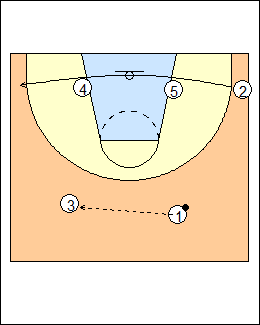 | 11 Options - 2 can cut up the middle - 2 can start in the high post - the weakside post flashes high on a corner touch, or double-team - 4 and 5 screen for 2 - corner skip or diagonal post pass against 1-3-1 zone - drag action out of the corner. Doug Schakel - attack a 1-2-2 zone with two guards, two low posts, and a rover. Heath Millar - 3 dribble freezes to occupy the top and wing defenders, make the back of the zone come out to the corner on a pass. Coach K - look for 5 to flash to an open area then go back, stay behind the zone. See Duke (three deep), Atkins baseline, Runner (double low posts), Dave Odom rover (against a 2-3 zone), Heath Millar continuity, 5star baseline, Kermit Davis vs 1-3-1, Schepp vs 1-3-1, Syracuse vs 1-3-1, also Pitt vs 1-3-1.  |
 | 12 Also see High-low basics. a) 3-out 2-in 4 and 5 x-cut on ball reversal, see Pitt, Hurley basic set (start with 4 and 5 on the baseline). Other post-movement options - x-cut low post, high post (Bill Self, Memphis) - the low post steps out to the short corner (Self, Heath Millar, UConn) - x-cut short corner, mid-post (Kermit Davis zone motion, Bruce Weber) - stay on ball reversal and screen the back of the zone (Canada Basketball). Sherri Coale - the weakside post attacks the area where the (on-ball) defender comes from (high post or short corner), the ballhandler must know where his defender came from. For other options (e.g. motion, drag action, bleeding on a skip pass, screening), see Self, Pitt, 5star high-low, Davis, Millar. For other entries, see Geno Auriemma (shallow cut), Izzo arm chop (4 ballscreens), Memphis (1-4), UConn (4-out with trailer), and Maryland Women (dribbling off centre).  |
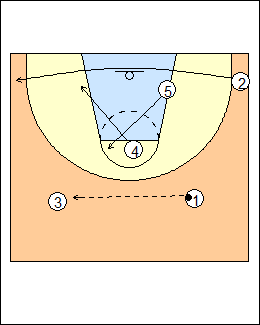 | 13 b) Overload Two-guard front, baseline runner, 4 and 5 x-cut. See T-game (double-post), Steve Bzomowski. For other options (e.g. entries, ballscreens, drag action), see Huggins dive and fill, Atkins North Carolina t-game, Kermit Davis four high, Atkins high, Heath Millar, also Dave Odom vs 1-3-1.  |
This page was made with Basketball playbook from Jes-Soft